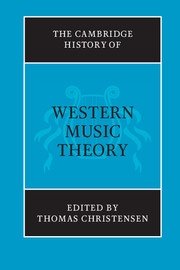Book contents
- Frontmatter
- Introduction
- PART I DISCIPLINING MUSIC THEORY
- PART II SPECULATIVE TRADITIONS
- PART III REGULATIVE TRADITIONS
- A Mapping tonal spaces
- B Compositional Theory
- C Time
- D Tonality
- 23 Tonality
- 24 Rameau and eighteenth-century harmonic theory
- 25 Nineteenth-century harmonic theory: the Austro-German legacy
- 26 Heinrich Schenker
- PART IV DESCRIPTIVE TRADITIONS
- Index of authors
- Index of subjects
- References
25 - Nineteenth-century harmonic theory: the Austro-German legacy
from D - Tonality
Published online by Cambridge University Press: 28 March 2008
- Frontmatter
- Introduction
- PART I DISCIPLINING MUSIC THEORY
- PART II SPECULATIVE TRADITIONS
- PART III REGULATIVE TRADITIONS
- A Mapping tonal spaces
- B Compositional Theory
- C Time
- D Tonality
- 23 Tonality
- 24 Rameau and eighteenth-century harmonic theory
- 25 Nineteenth-century harmonic theory: the Austro-German legacy
- 26 Heinrich Schenker
- PART IV DESCRIPTIVE TRADITIONS
- Index of authors
- Index of subjects
- References
Summary
Today most scholars agree that Rameau was the founder of modern harmonic theory. As we have seen in the previous chapter, Rameau attempted to synthesize in his many writings a multiplicity of ideas – both old and new, speculative and practical – into a unified theory of tonal harmony grounded upon a single underlying principle, the corps sonore (see Chapter 24, pp. 759–71). If he did not succeed in creating a truly systematic and stable theory of harmony owing to his many differing and often contradictory theoretical arguments and intellectual borrowings, he nonetheless bequeathed to the nineteenth century a number of compelling and richly suggestive ideas that would inspire theorists in their own efforts.
In this chapter, we will look at the evolution of harmonic theory in the nineteenth century. This is of course a vast and complex topic. Given the profound changes in harmonic language between 1800 and 1900 – a period covering the end of Viennese Classicism and closing with Schoenberg’s first tentative steps beyond the tonal system – it is not surprising that theorists expended extraordinary energy and efforts in their attempts to rationalize this shifting practice. As it is impossible here to describe all of these efforts in detail, we will limit our scope to the development of Austro-German harmonic theory, a tradition which arguably encompasses some of the most innovative and influential writings on this topic for the entire century. Within this tradition, three individual trajectories can be traced back by differing routes to Rameau’s own theory: scale-degree (Stufen) theory, fundamental-bass theory, and function theory.
- Type
- Chapter
- Information
- The Cambridge History of Western Music Theory , pp. 778 - 811Publisher: Cambridge University PressPrint publication year: 2002
References
- 9
- Cited by



